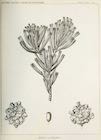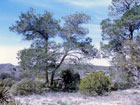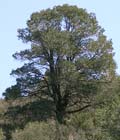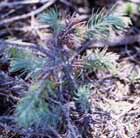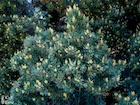Pinus quadrifolia
Parl. ex Sudw. 1897
Common names
Parry piñon, four-leaved nut pine, Sierra Juárez piñon. Indigenous names include tevat [Cahuilla] and ehwiiw [Kumeyaay], names which also apply to Pinus californiarum (display at Anza Borrego State Park).
Taxonomic notes
Pinus subsection Cembroides. Type: USA, California, "mountains E of San Diego", C.C. Parry 1390 (holo US). Synonymy:
- Pinus llaveana J.Torrey ex Emory 1858, non Schlectendahl 1838;
- Pinus parryana Engelmann 1862 non Gordon & Glendinning 1858;
- Pinus cembroides Zucc. var. parryana (Engelmann) A.Voss 1907;
- Pinus juarezensis Lanner 1974;
- Pinus cembroides Zucc. subsp. parryana (Engelmann) E.Murray 1982; and
- Pinus cembroides Zucc. var. quadrifolia (Parl. ex Sudw.) Silba 1984.
See Pinus cembroides for a general introduction to the phylogenetics of the piñons, a subject that has been greatly clarified by some highly detailed molecular studies; see also Pinus monophylla for further details. One outcome of the molecular studies is that the species P. californiarum, P. edulis, P. monophylla and P. quadrifolia form a monophyletic clade within subsection Cembroides, within which P. monophylla and P. quadrifolia are sister species. This was always intuitively apparent, since a cross-section of a P. monophylla needle shows it to basically be 5 fused needles, while the needles of P. quadrifolia often remain fused until forcibly separated by rolling the needle in your fingers. The close relationship between the species was shown by Gernandt et al. (2003), in a study of chloroplast DNA sequences in piñon pines, and was further demonstrated using multiple molecular lines of evidence by Montes et al. (2022). Buck et al. (2020, 2023) showed that interbreeding does occur between P. quadrifolia and P. monophylla (where they are sympatric in the San Jacinto Mountains), and also between P. californiarum and P. quadrifolia.
Lanner (1974) asserted that P. quadrifolia arose through the hybridization of P. monophylla with a Baja California pine that he described as P. juarezensis, but Buck et al. (2020) refute that idea in detail, and their findings were further confirmed by Montes et al. (2022). Thus is P. juarezensis reduced to synonymy.
Description
Trees 5-9(-15)m tall and up to 50cm dbh. Round, fairly straight single trunk, much branched within the crown which is dense and narrowly pyramidal in young trees, with age becoming irregularly rounded. Bark at first light gray and smooth, with age becoming red-brown, thick, scaly, longitudinally and horizontally furrowed. Branchlets slender, pale orange-brown, puberulent-glandular, aging brown to gray-brown; pulvini not decurrent. Buds ovoid, light red-brown, ca. 0.4-0.5 cm, slightly resinous. Leaves in fascicles of (4-)5, usually connate the first year, slightly curved, 1.5-6 cm × 1-1.7 mm, stiff, sharp, green to blue-green, margins entire, finely serrulate, apex subulate, adaxial surfaces mostly strongly whitened with stomatal bands, resin canals (1-)2(-3), dorsal; fibrovascular bundle single; leaves persisting 3-4 years. Fascicle sheath 5-9 mm long, curling into rosettes, later deciduous. Pollen cones ovoid, ca. 10 mm, yellowish. First-year cones borne singly and in pairs on slender, short peduncles; globose with thick, transversely keeled scales. Second-year cones mature subglobose, symmetrical; (3-)4-10(-10) cm long when open, pale yellow-brown, soon deciduous when mature, the peduncle very small and falling with the cone. Cone scales few, only the central scales seed-bearing; apophysis rhomboidal, strongly raised, transversely keeled; the umbo dorsal, flat to depressed, bearing a minute early deciduous prickle. Seeds brown, wingless, 14-17 × 6-8 mm; seed coat 0.2-0.3 mm thick; endosperm white (Little 1980, Perry 1991, Kral 1993).
See P. monophylla for discussion of how genetic mixing affects identification of P. quadrifolia hybrids with P. californiarum or P. monophylla.
Distribution and Ecology
US: S California and Mexico: Baja California Norte; distributed in mountains from the southern San Jacinto massif to the Sierra San Pedro Mártir. Habitat is semi-arid to arid foothills and mesas at altitudes ranging from 1100 to 2000 m. Rainfall at the lower elevations generally does not exceed 500 mm annually and temperatures may drop to freezing during the winter months. At the higher altitudes (1600-2000 m) frosts often occur during the winter and annual rainfall may reach 600 mm with about 30% occurring in the form of snow and sleet (Perry 1991). Hardy to Zone 8 (cold hardiness limit between -12.1°C and -6.7°C) (Bannister and Neuner 2001). See also Thompson et al. (1999).
Distribution map. Green represents P. monophylla, red is P. californiarum, purple is P. edulis, blue is P. × kohae, and orange is P. quadrifolia. Pinus californiarum, P. × kohae, and P. monophylla polygons by Cole (2003), based on a climate-calibrated habitat model. P. edulis and P. quadrifolia polygons by USGS (1999), based on professional judgement by E. L. Little. All point data from GBIF, DOIs = https://doi.org/10.15468/dl.7acmds (P. edulis var. fallax), https://doi.org/10.15468/dl.twthv7 (P. californiarum), https://doi.org/10.15468/dl.5unbjc (P. monophylla), and https://doi.org/10.15468/dl.qugjbg (P. quadrifolia); all accessed 2023.03.11. GBIF data processed to add coordinates based on narrative descriptions, and remove duplicates.
My field observations suggest that P. quadrifolia grows in a variety of forest formations depending on available moisture. At the mesic end of the scale, it occurs as an understory tree and on locally droughty sites within Pinus jeffreyi forests having canopy closure less than 67%. As site moisture decreases, P. jeffreyi is increasingly restricted to riparian areas and then is excluded completely. At these moisture levels, P. quadrifolia forms continuous stands of tens to thousands of individuals, sometimes with crown closure as high as 90%. On still more xeric sites, crown closure is lost and P. californiarum becomes an increasingly important component of the stand, as does Juniperus californica and various nonconiferous chaparral shrubs such as manzanitas (Arctostaphylos sp.). On the driest sites, P. quadrifolia disappears, leaving a P. californiarum--J. californica stand. I suspect that fire is an important determinant of stand dynamics on sites with potentially high canopy closure, simply because such settings develop fuel loadings sufficient to carry a fire and the nonconiferous component is dominated by chaparral, a characteristic fire-dominated community. Within the historical era, stand dynamics have also been modified by forest clearing to increase available forage for cattle.
The IUCN classifies this subspecies as "Least Concern" for human impacts due to large extent of occurrence and the absence of evidence for recent or ongoing population declines (Farjon 2013).
"The rather large, thin-shelled seeds are gathered for food by birds and rodents" (Perry 1991).
Remarkable Specimens
One big tree has diameter 70 cm, height 16 m, crown spread 13 m; it grows in Riverside County, California (American Forests 1996). In 2023 I found a comparably-sized tree near Penrod Canyon, California, but neglected to measure it. Larger individuals likely exist.
There seem to be no age data, except that I have counted rings on a few stumps and found nothing exceeding 200 years. Considering its dry and cool habitat, twice that age would not be surprising.
A stand of P. quadrifolia can be seen at the California Botanic Garden in Claremont, California. I wondered how diligently they must have searched to find so many 4-needle trees. The trees have done very well in Claremont, so much so that they now form a stand as dense and dark as any thicket, virtually devoid of an understory.
Ethnobotany
The seeds are "sold on the market as pine nuts along with the seeds of P. edulis and P. monophylla ... Like most of the nut pines, the trunk is short and small in diameter and thus hardly useful for sawn lumber. However, it is used locally for posts and firewood" (Perry 1991).
Wilken (2012) details use of piñon by the Kumeyaay indians, who did not distinguish between Pinus californiarum and P. quadrifolia. He notes that the piñon was one of the most important foods for these people; "In late summer, the Kumeyaay, their neighbors the Ko’alh and the Paipai, regularly traveled to the great stands of pinyon to gather this highly prized and oil rich food," and that some Cucapá families also made the journey from the Colorado River desert to participate in the harvest. Harvest areas would be scouted in advance to determine the size of the crop, and which trees bore the most seeds; the harvest would sometimes last for weeks. The trees would be climbed, and the green cones cut and roasted in pits fueled by burning sagebrush (Artemisia tridentata), before removing the nuts. Later in the season, when the cones opened, harvesters would climb the trees and shake the branches to release the nuts; however an earlier harvest was preferred, before birds or rodents could forage the trees. The Kumeyaay would usually roast the nuts, though they could be eaten raw, and would sometimes grind the seeds on a metate and make them into a pinole, a gruel popular with people who lack teeth. The Cahuilla would commonly grind the nuts and make them into a drink or a mush. The Paipai would trade pine nuts for with peoples of the Colorado River desert region, or with merchants, in exchange for other types of food. There were also stories about the nuts: "During his 1948–49 fieldwork, Hohenthal (2001) recorded a story about a rock formation at Agua Hechicera (Ha ‘kusiyai) that resembled an open sack of pine nuts. According to his consultant María Osuna of the Kumeyaay settlement of Manteca, there was a big dance where a sack of shelled pine nuts was set on a rock for the guests to eat. When an uninvited guest thrust his hand in the sack, it turned to stone."
Observations
Most Americans will see this tree in a pure stand near the radio transmitters at the summit of the Laguna Mountains east of San Diego. It is also an extremely common pine in the Sierra Juárez of Baja California Norte. A drive south from Mexico Highway 2 to the Parque Nacional Constitución de 1857 will take you through many kilometers of groves, and it is a common understory species at the park. You may find these locations useful:
Nice mixed stand (with P. californiarum) at 32.3018°N, 115.9371°W.
Growing with a minor component of P. jeffreyi at 32.2026°N, 115.9360°W.
Dense single-species stand with lots of seedlings at 32.1883°N, 115.9277°W.
Remarks
In 1850 C.C. Parry, as part of the United States and Mexican Boundary Survey (page 208-9; Plate LIII), collected this species in the "mountains east of San Diego," presumably the Laguna Mountains. This is an area where many trees bear 4-needled fascicles, thus the epithet quadrifolia in this usually 5-needled species.
Citations
American Forests 1996. The 1996-1997 National Register of Big Trees. Washington, DC: American Forests.
Buck, Ryan, Sandra Hyasat, Alice Hossfeld, and Lluvia Flores-Rentería. 2020. Patterns of hybridization and cryptic introgression among one- and four-needled pinyon pines. Annals of Botany 126(3):401–11. https://doi.org/10.1093/aob/mcaa045.
Buck, Ryan, Diego Ortega-Del Vecchyo, Catherine Gehring, Rhett Michelson, Dulce Flores-Rentería, Barbara Klein, Amy V. Whipple, and Lluvia Flores-Rentería. 2023. Sequential hybridization may have facilitated ecological transitions in the Southwestern pinyon pine syngameon. New Phytologist 237:2435–49. https://doi.org/10.1111/nph.18543.
Cole, Kenneth. 2003. Map sources for the ranges of one- and two-needled pinyons. http://sbsc.wr.usgs.gov/cprs/research/projects/global_change/RangeMaps/PinyonMapSources.pdf, accessed 2012.04.25, now defunct.
Farjon, A. 2013. Pinus quadrifolia. The IUCN Red List of Threatened Species 2013: e.T42407A2977910. https://dx.doi.org/10.2305/IUCN.UK.2013-1.RLTS.T42407A2977910.en, accessed 2023.03.10.
Hohenthal, William D., Jr. 2001. Tipai Ethnographic Notes: A Baja California Indian Community at Mid-Century.
Menlo Park, CA: Ballena Press and the Institute for Regional Studies of the Californias.
Montes, José‐Rubén, Pablo Peláez, Alejandra Moreno‐Letelier, and David S. Gernandt. 2022. Coalescent‐based species delimitation in North American pinyon pines using low‐copy nuclear genes and plastomes. American Journal of Botany 109(5):706–726. https://doi.org/10.1002/ajb2.1847.
Sudworth, G. B. 1897. Nomenclature of the arborescent flora of the U.S. U.S.D.A. Division of Forestry Bulletin 14 (p. 17). Available: Internet Archive, accessed 2023.03.10.
Wilken, Michael Alan. 2012. An ethnobotany of Baja California's Kumeyaay indians. M.A. Thesis, San Diego State University.
See also
Elwes and Henry 1906-1913 at the Biodiversity Heritage Library (as P. parryana). This series of volumes, privately printed, provides some of the most engaging descriptions of conifers ever published. Although they only treat species cultivated in the U.K. and Ireland, and the taxonomy is a bit dated, still these accounts are thorough, treating such topics as species description, range, varieties, exceptionally old or tall specimens, remarkable trees, and cultivation. Despite being over a century old, they are generally accurate, and are illustrated with some remarkable photographs and lithographs.
